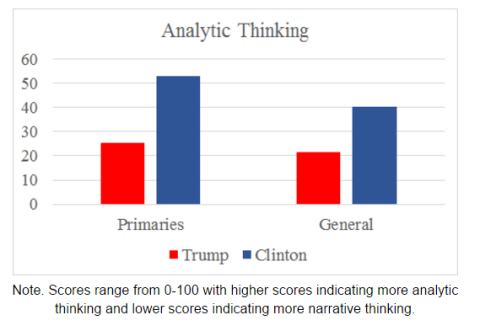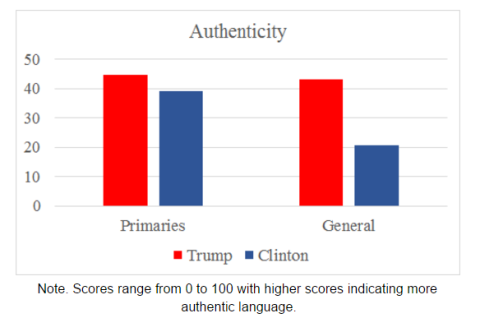A Look into the First Clinton-Trump Debate
September 27, 2016
Kayla N. Jordan and James W. Pennebaker
University of Texas at Austin
This week Hillary Clinton and Donald Trump met on the debate stage for the first time. In looking at their language so far, we have found the candidates to be remarkably consistent with their earlier primary debates in their language styles. Throughout their campaigns both candidates have faced numerous challenges to their temperaments and their honesty. Given the perceptions of their weaknesses, the candidates may have tried to change how they approached the debate their first presidential debate. We examine two ways the candidates may have changed: (1) are they more analytic or more narrative and (2) are they more authentic or more distant?
Analytic Thinking
As we have discussed in previous posts, people differ in the ways they think. Some people think in a formal, logical manner indicated by the greater use of nouns, articles, and prepositions. Others rely more on stories and narrative communicating in an informal manner using more pronouns, auxiliary verbs (e.g. is, have, was), and common adverbs (e.g. really, so, very).
During the primary debates, Clinton spoke using a formal, analytic style. She focused on her policy proposals and issues and laid them out in a logical fashion. Trump had a shoot-from-the-hip, informal way of speaking using stories and anecdotes to explain his thinking. Have their thinking styles changed? In Trump’s case, no. As you can see in the graph below, his numbers are virtually identical. Trump remains very much a narrative, intuitive thinker. Clinton, on the other hand, was more narrative than normal at this debate getting closer to Trump’s thinking style. Given her opponent and some of the criticisms she has faced, Clinton may have tried to be more personable and less formal to better appeal to voters.

Authenticity
The words people use also reflect how authentic or personal they sound. People who are authentic tend to use more I-words (e.g. I, me, mine), present-tense verbs, and relativity words (e.g. near, new) and fewer she-he words (e.g. his, her) and discrepancies (e.g. should, could).
In the primary debates, both Trump and Clinton came across as relatively authentic and personal though Clinton was a bit more distant. Have the candidates changed? Once again, Trump has changed very little since the primaries. He is still speaking his mind in straight-forward, authentic way. Clinton, however, has changed rather dramatically. After a few recent scandals, it is perhaps somewhat unsurprising that Clinton has become more distant and inauthentic.

The Big Picture
As Clinton said in the debate, “words matter.” Indeed, the words people use reveal important facets about them. So what does the debate language of Clinton and Trump say about them?
Clinton. Clinton’s language has changed the most from the primary debates. She went from being analytic to more narrative and from relatively authentic to rather distant. By all accounts, she spent quite a bit of time preparing for the debate to change the way she speaks to address criticisms she has faced. Her drop in authenticity could be a result of consciously altering how she normally speaks. Her drop in authenticity may also give people a sense of her being more authoritative. Given the way she has been criticized for not being open (despite often being more accurate than Trump according to fact checkers like CNN and PoliFact), shifting back to her more honest style might be in order.
Trump. When not reading from a script, Donald Trump is remarkably consistent. Trump says what he thinks and believes in what he says. Unlike Clinton, Trump did not seem to spend much time preparing for the debate. For better or worse, Trump is who he is and may not change to court new voters or change people’s perceptions.